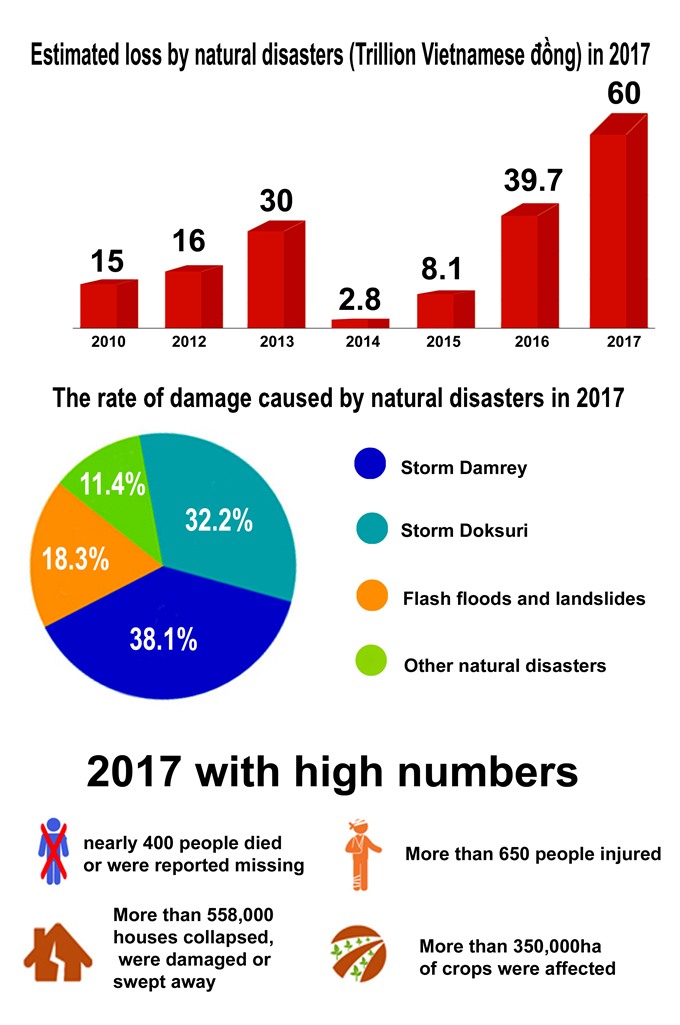 Society
Society

Việt Nam experienced unprecedentedly severe natural disasters in 2017, resulting in 386 people dead and missing and some VNĐ60,000 billion (US$2.6 billion) worth of damages.
 |
| VNA/VNS Infographic. Source: Ministry of Natural Resources and Environment. |
HÀ NỘI — Việt Nam experienced unprecedentedly severe natural disasters in 2017, resulting in 386 people dead and missing and some VNĐ60,000 billion (US$2.6 billion) worth of damages.
Hydro-meteorology experts concluded that 2017 was the year of extreme weather events.
According to the report issued by the Việt Nam Disaster Management Authority, 2017 witnessed a record 16 storms and six tropical depressions in the East Sea. Two of the storms were severe: storm No. 10 (Doksuri) struck the North Central region in mid-September and storm No. 12 (Damrey) hit the South Central region in November.
Natural disasters in 2017 were considered complicated, unseasonable and unpredictable.
Heavy and prolonged downpours occurred from June to October, with rainfall exceeding the average from 10 to 30 per cent, in several areas including Hà Giang Province’s districts of Bắc Quang and Việt Lâm (4,983 mm and 3,836 mm respectively), Thừa Thiên–Huế Province’s Phú Ốc District (4,360 mm) and Quảng Ngãi Province’s Sơn Giang District (3,620 mm). The flooding triggered by the Doksuri storm nearly reached the historic level of 5.18m in 1999.
In northern mountainous provinces, landslides and flash floods occurred frequently. The flash flood on August 3 in Nậm Păm Spring, Mường La District, Sơn La Province, for example, killed 15 people and swept away about one million cubic metre of soil. On the same day, another flash flood demolished a residential area in Mù Căng Chải Town, Yên Bái Province, causing eight deaths, six missing-person cases and damage to 40 houses and Võ Thị Sáu primary and secondary school. Two months later, from October 9 to 12, under the impact of a tropical depression and cold air, the northern mountainous area continued to experience severe flooding. On October 11, Hoà Bình Reservoir opened eight floodgates after heavy rains caused a rapid rise in the water level.
The heaviest storm in the last 30 years, the Damrey storm, hit the South Central provinces of Phú Yên and Khánh Hoà at 133km per hour. After nine hours, the storm had killed 44 people, damaged 114,000 houses in Khánh Hoà Province and caused landslides. At Quy Nhơn Port in Bình Định Province, ten vessels sank, leading to the deaths of several crew members.
The storm circulation and cold air led to heavy downpours from Thừa Thiên–Huế Province to Bình Thuận Province as well as in the Central Highlands, affecting the lives of 4.3 million people. The total loss caused by the Damrey storm was estimated at VNĐ22,680 billion ($1 billion).
In 2017, 16 storms and six tropical depressions formed in the East Sea, of which five storms and three tropical depressions directly hit Việt Nam.
Severe disasters resulted in 386 people being declared dead or missing, 122 more people than in 2016 and 86 more people than the average number of the past decade. Economic losses amounted to VNĐ60,000 billion ($2.6 billion), a 30-per cent increase compared with 2016 and 2.5 times higher than the average of the past decade.
Poor natural disaster preparedness
Nguyễn Đức Quang, head of the Natural Disaster Preparedness Department under the Ministry of Agriculture and Rural Development, said several localities had demonstrated poor preparedness.
The financial source for natural-disaster preparedness is still limited and depends heavily on the State budget, causing obstructions in allocations.
Trần Quang Hoài, head of the Việt Nam Disaster Management Authority, stressed on the shortage of State budget funds for natural disaster relief and reconstruction.
In addition, shortcomings in mobilising support from social and international organisations are major difficulties hindering the process of disaster recovery and reconstruction.
The capacity of natural disaster preparation agencies is still limited, so the process of monitoring and warning of danger is poorly handled.
Further, the lack of disaster resilience skills and emergency information systems are also to blame for the enormous losses caused by natural disasters in 2017.
According to the predictions of domestic and international agencies, under the impact of climate change, natural disasters and extreme weather events will occur more frequently, causing serious damage. — VNS




